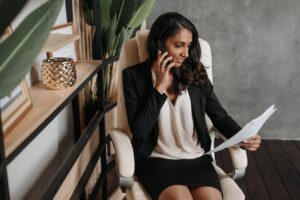Interviews with subject matter experts and “real people” give media coverage color and credibility. But if you only have 10 minutes with an expert, how can you make the most of that time and get all the information you need?
This checklist offers some tips and strategies for reporters before and during an interview. Even if talking to sources is common place for you, it’s worth a quick refresher.
Before the interview
Check time zones
If you’re conducting an interview virtually or over the phone, make it clear what time zone you’re in and ask the source for theirs. It’s not unusual for people to assume you’re in the same time zone, which can lead to missed calls and frustration all around.
Verify this is the correct person to interview
The last thing you want is to schedule an interview with someone only to have them pass you off to a colleague or discover that they misunderstood what you need. Unless you’re doing an investigative piece where you don’t want to show your cards, explain the kind of expertise you’re looking for and confirm the job title of the person you’re interviewing so you don’t wind up talking to the wrong person.
Double-check your technology
If you plan to record the interview, take a few minutes beforehand to check your recording equipment. Allow enough time for a software update or have replacement batteries and memory cards on hand. You wouldn’t want a technical glitch to hinder the interview.
On/Off the record
Clarify whether the interview will be “on the record”, meaning fully attributable to the interviewee, or “off the record.” The latter term doesn’t have a single definition: some people might interpret it to mean none of the interview can be used in the news story (it’s just background for the reporter) while others might think the information is usable but only attributable to an anonymous source. Once the agreement is reached, it should be honored by both sides.
Clarify attribution
Confirm how your interviewee will be identified in the story; it is best practice to identify sources as fully as possible, ideally by full name and title on first reference. Some sources, however, might ask for anonymity to discuss sensitive subjects. Reporters should ask why a source doesn’t want to be identified fully (e.g. fear of losing job, revealing confidential information, etc.) and include that reason in the story. Try to negotiate as precise a description as possible without endangering your source: citing a “nuclear physicist with first-hand knowledge of the project” is better than “a person familiar with the situation”.
During the interview
Ask permission before recording
Always ask the source’s permission before recording. It can help to state that you are recording the interview so you can accurately quote them.
Verify name spelling and title
Even if you’ve quoted someone before, always reconfirm their name and title in case anything has changed. If the job title they give you doesn’t match what’s on the company website or their LinkedIn profile, ask for clarification, especially if you know a fact-checker will cross-reference those materials.
Confirm pronouns
Don’t make assumptions based on someone’s photo or the sound of their voice. Ask what pronouns your source uses so you can correctly identify them.
Ask what else you should know
It’s handy to conclude interviews by asking the person if there’s anything else you should know about the topic or if there is anyone else you should talk to.
Finally, explain the next steps
Some sources are more media-savvy than others, but it is always helpful to give them a heads up on next steps. Do you plan on emailing them the next day with follow-up questions? Should they expect to hear from a fact-checker? Does the art director need photos? Publication dates are often subject to change, but if you can give them a ballpark on when the piece might be published, you’ll reduce the number of emails you get asking “has this published yet?”






